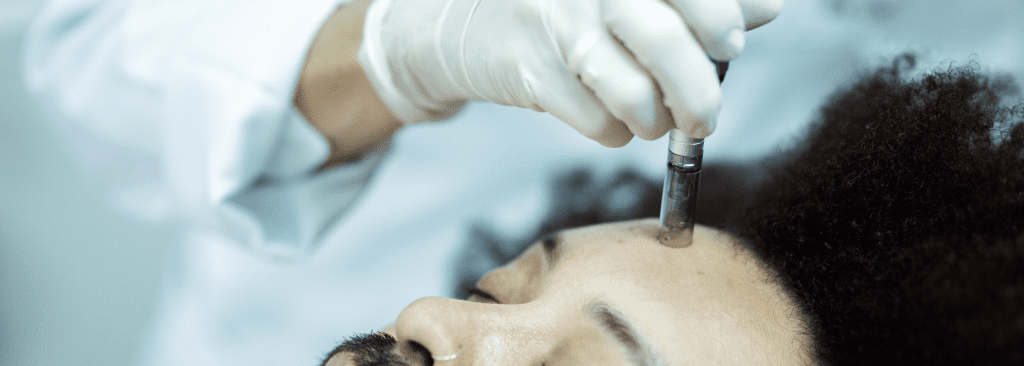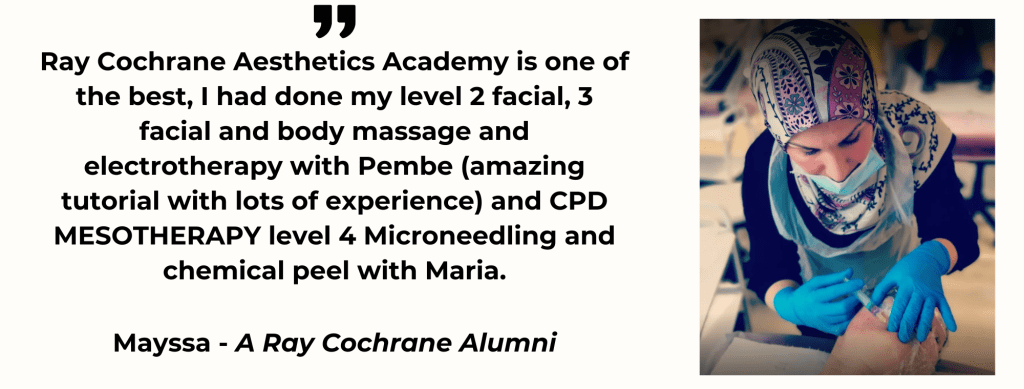
Through this blog, we share the expertise of our school Director and the proud owner of Dermacure Clinic, Eleonora Androva, as she compares two popular aesthetic treatments: Mesotherapy and Microneedling. Eleonora’s insights and experience will guide professional therapists aspiring to expand their services with the most modern needle-based aesthetic therapies. In the aesthetic industry, Mesotherapy and Microneedling have become the talk of the town due to their abilities to transform clients’ skin. Both of these therapies effectively address skin issues such as acne scarring, stretch marks, and typical skin concerns related to ageing. Although both Mesotherapy and Microneedling procedures use needling techniques, they differ in the needle’s length, the number of needles used, the depth of skin penetration, and delivery speed, all ultimately impacting the skin conditions/areas they can target.

With Eleonora’s wisdom in this blog, we will properly explain two of the industry’s most suitable and sought-after treatments to help aspiring/professional aestheticians make a well-informed choice for their clientele.
What is Mesotherapy?
First introduced in the 1950s, Mesotherapy is a popular aesthetic cell regeneration treatment that combines a single injection with unique active ingredients to boost skin firmness and elasticity. This procedure can be done on the face for a youthful appearance or on different body areas to enhance and reshape the figure.
The Aesthetician carrying out the treatment will create punctures in the skin with an injection, allowing the cocktail of vitamins, minerals, acids and enzymes into the middle layer of the skin. Mesotherapy literally translates to medium therapy.
With needleless Mesotherapy, the serum of active ingredients is first applied, and then mild ultrasonic waves make the skin temporarily more porous and absorb the active ingredients.
We want to point out that we refer to needle-injected Mesotherapy. Whilst there is needleless Mesotherapy, we prefer the needle mesotherapy here at Ray Cochrane, which is the method we teach our students using a single needle and the Mesogun as research has found that it is more transformative for the client’s skin.
What is Microneedling?
Becoming popular in the 1990s, Microneedling uses multiple ultrafine needles to penetrate the skin, intending to create wounds in the skin. In turn, the ‘wounded’ area will promote the skin to go into healing mode, producing more collagen and elastin. Many will refer to Microneedling as Collagen induction therapy.
Before starting the Microneedling treatment, the Aesthetician will apply products/serums to the face before they start needling, as the micro holes created will ensure the product is absorbed into the skin.
There are three types of microneedling devices often used, all of which we teach our students at Ray Cochrane:
- Derma roller
- Derma stamp
- Microneedling Pen – (automatic)
There are exclusive benefits to the Mirconeedling device that you choose. For example, with a Microneedlign Pen, you can precisely adjust the needle depth, ranging from 0.5 to 2.5mm, allowing for targeted penetration either deep into the skin or just beneath the surface. However, when starting up your Microneedling treatments as a beginner, you may decide you are not ready to invest in a Microneedling pen. Hence, a Derma roller is an affordable entry point to offering treatment.
Mesotherapy vs Microneedling: Differences and Similarities
So as mentioned earlier, aside from the fact both of these aesthetic treatments are needle-based, they are very different. They differ in the following aspects:
- needle length
- number of needles used
- depth of skin penetration
- treatment delivery speed
- areas they are used to treat
One of the main differences between Microneedling and Mesotherapy is the depths of the skin they penetrate. Mesotherapy targets the middle layer, called the dermis while Microneedling treatments will target the first layer, the epidermis. However, it is worth mentioning that with the modern advancements in Microneedling, it can now target the dermis. The rule of thumb in any needling treatment is that if blood is drawn, it’s targeting deeper than the first layer of the skin.
Because of the difference in depth, Mesotherapy is more suited to fixing the skin’s long-term general health, i.e., fine lines, cellulite, sagging skin and uneven skin tone. Microneedling, as it targets the most superficial layer of skin but promotes collagen, is better suited to treating acne scarring, deeper signs of ageing and other texture-related skin concerns.
Again the skin depths they target also impact the needle length; as Mesotherapy targets deeper, the needle will be longer. Needle length is vital when considering that some clients may fear needles; thus, they may prefer the treatment with a shorter needle.
Mesotherapy consists of a single injection, whilst Microneedling treatments consist of multiple fine needles. The single needle allows more precise therapy in sensitive areas like the eyes to target dark circles. Microneedling with multiple needles will allow the Aesthetician to target more surface area quicker, especially when using a Microneedling pen.
Finally, depending on what device is used to deliver treatment, it may impact which is quicker. If the Aesthetician uses an automatic microneedling pen, the treatment will be faster than a single meso injection and vice versa, where a mesogun would be swifter than a Derma roller.
Now that we’ve explained the differences and similarities, you will wonder who is more suitable for what treatment. Fully understanding your clientele’s suitability will allow you to choose the right training course to invest in as an aesthetician.
What is the Purpose of Microneedling?
Microneedling is a highly effective treatment suitable for various skin issues, particularly surrounding the face and neck:
- lighten and reduce scarring – acne and surgical
- hyperpigmentation
- hair loss
- wrinkles and fine lines
- texture related issues
The primary purpose of Microneedling is skin rejuvenation, as it promotes cell regeneration on a deeper level, encouraging the production of new skin cells. Acne scars on the face, wrinkles around the eyes and neck, and surgical scars on the abdomen respond well to Microneedling treatment.
Microneedling is great for targeting signs of ageing because the needles trigger the skin’s wound response. In turn, it triggers the release of healing properties, including producing new collagen and elastin.
Aestheticians may even encourage clients considering injectables like Botox or dermal fillers to consider microneedling beforehand.
For Aesthetic practitioners, microneedling is a versatile solution to various client concerns on the face and neck, especially now that it is commonly combined with other innovative technologies like Radiofrequency and chemical peels for maximised results.
What is the Purpose of Mesotherapy?
Mesotherapy is an adaptable solution for various skin concerns, including:
- fine lines
- wrinkles
- hyperpigmentation
- dehydrated and dull skin
- loose skin
- localised fat
Its effectiveness stems from its ability to target issues within the skin’s middle layers, making it a powerful solution against cellulite, saggy skin, and other problems.
Notably, it is also an excellent option for individuals with body insecurities, as it can enhance the appearance of these areas. Targeting areas of fat through Mesotherapy works by injecting those areas with a solution that breaks down the fat. Through Mesotherapy, clients can spot reduce fat which is otherwise impossible without surgical treatment.
The treatment’s cocktail injections contain essential ingredients that promote long-term skin health and effectively combat pigmentation issues, such as dark under eyes or skin discolouration, by eliminating toxins from the skin cells. Mesotherapy is also a great choice, as serums can be custom-made depending on the client’s desired results.
As mentioned earlier, this blog is to help aspiring Aestheticians and already-qualified Beauty Therapists introduce the newest and most relevant treatments to their clients. So now that we’ve answered, “What is the difference between Mesotherapy and Microneedling?” The next question is, “How do I learn to provide Microneedling treatment?” or “How do I get qualified in Mesotherapy?”
This is where Ray Cochrane Beauty Aesthetics Academy comes in! The leading Beauty and Aesthetics training school in London since 1954.
How to become a qualified Mesotherapy Technician?
For those aspiring to become a qualified Mesotherapy Therapist, complete a Mesotherapy CPD course. A CPD-accredited course ensures that professionals continue receiving updated training to further them in their profession. But because they already have the basic training in their profession, they can complete the CPD course quickly. Our Mesotherapy course is only available for those with their Level 3 Beauty Therapy Diploma, allowing them to complete the CPD course in just one day! It is worth noting, though, the course is considered intensive due to the amount of information learners will be taking in.
Throughout the day, students are taught by the best in the industry. Our tutors delivering the CPD Mesotherapy course are still actively working in the Aesthetics industry, providing the same treatment to their clients daily. This hands-on experience allows them to pass on their tips and tricks to students ensuring you are learning the most up-to-date techniques.
The two types of Mesotherapy techniques taught in the course, single-needle Mesotherapy and Mesogun and practised on a live model provided by the academy.
Aside from learning how to use different Mesotherapy techniques, the course teaches:
- a revision of learners existing skin anatomy and physiology
- the history of Mesotherapy
- treatable skin conditions
- contraindications
- products and ingredients used in Mesotherapy,
- the client consultation process
- Mesotherapy aftercare.
All of this ensures that by the end of the course, learners know everything they need to administer the Mesotherapy treatment professionally and safely.
How to become a trained Microneedling Technician?
If you want to train in Microneedling, consider our Level 4 Microneedling/ Skin needling course. Compared to the Mesotherapy course, our Microneedling course spans over 12 weeks. However, it is a part-time option allowing working therapists and aestheticians to get their training whilst still working and treating clients. By the end of the 12 weeks, after completing their theoretical and practical learning, students can provide cosmetic skin peeling treatments.
Those interested must have their Level 3 Beauty Therapy Diploma to enrol on the training course. It’s also suitable for medical professionals interested in offering advanced aesthetic procedures.
The training teaches students to deliver Microneedling to clients with a Microneedling Pen, Dermaroller and Dermapen by practising on a live model. Students will learn to select the appropriate needle size, treatment length, and strength while monitoring client reactions.
Aside from using learning to use the suitable device, this course enables students to become qualified Microneedling therapists by teaching:
- safety concerns and anatomy relevant to Level 4 aesthetic treatments
- health and safety considerations
- client consultations
- contraindications
- patch testing
- post-treatment care
- customer service
- communication skills.
Why Choose Ray Cochrane for Mesotherapy or Microneedling Training?
There are many reasons why Ray Cochrane Beauty Aesthetics Academy is the leading beauty aesthetic training centre in the UK and an excellent choice for anyone looking to upgrade their aesthetic offerings.
Firstly, our exceptional tutors! All tutors at Ray Cochrane actively work in the Beauty and Aesthetics industry through their own clinics or with other professionals. We choose tutors still working in the industry as that ensures they are up to date with the latest treatments and techniques, which puts our students ahead of other schools’ alums. Students can ask these working tutors for tips and tricks to put them ahead in the industry.
Secondly, the modern equipment and products we use. Similarly, how better clinics use better products is the same for Beauty and Aesthetics training providers. At Ray Cochrane, we use the best products and equipment proven to work, making it easier for our students to transition to working in high-end clinics and spas.
Finally, we are highly recommended by our Alumni. We have over 100 5-star reviews on Google, which you can check out. Many of our students return to us to further their training, with some completing their Level 2, Level 3 and Level 4 qualifications with us. If you would like to read our Google reviews, please feel free to do so here.

You can contact us for a no-pressure consultation to learn more about our CPD-accredited Mesotherapy or Level 4 Microneedling course. Our course consultants will only speak to you and advise you of the best course for your interests without pressuring you to enrol.
Our offices are open 9 am – 5 pm, where you can reach us via phone on 0207 486 6291. Alternatively, you can email us anytime at email@raycochrane.studiocoact.co.uk, and we’ll strive to get back to you ASAP.
